Native
Platynota stultana Walsingham (Tortricidae: Tortricinae: Sparganothini)
Common names: omnivorous leafroller
Synonyms: chiquitana (Platynota)
FWL: 4.5-7.0 mm (males); 6.5-9.0 mm (females)
Male forewings are usually dark brown on the basal half and golden brown on the distaldistal:
farthest from body, distant from point of attachment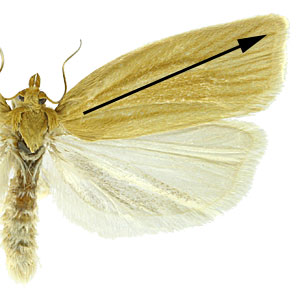 half. Female forewings are more uniform golden brown to dark brown and markings are usually less distinct. Labial palpilabial palpi:
half. Female forewings are more uniform golden brown to dark brown and markings are usually less distinct. Labial palpilabial palpi:
a pair of sensory appendages that project from the lower part of the head; usually covered in scales and three-segmented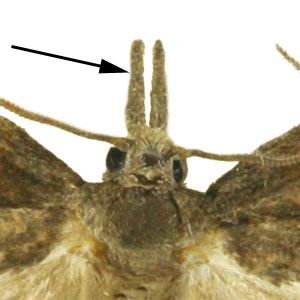 are extremely elongate in both sexes. Males have a forewing costal foldforewing costal fold:
are extremely elongate in both sexes. Males have a forewing costal foldforewing costal fold:
a flap or fold at the base of the forewing that contains specialized sex scales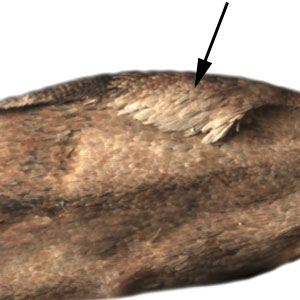 . The hindwing is golden brown to pale brown.
. The hindwing is golden brown to pale brown.
Male genitalia are characterized by a long, spindle-shaped uncusuncus:
a sclerotized process which is fused to the posterodorsal margin of tergum IX , broadest at midpoint; large, setosesetose:
, broadest at midpoint; large, setosesetose:
covered with setae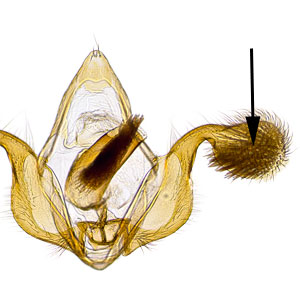 socii; a spined transtilla; and broad, rounded valvaevalvae:
socii; a spined transtilla; and broad, rounded valvaevalvae:
plural of "valva" . Female genitalia are characterized by a broad, bowl-shaped sterigmasterigma:
. Female genitalia are characterized by a broad, bowl-shaped sterigmasterigma:
the sclerotized region surrounding the female ostium bursae  and a minute, wrinkled sclerite near mid-dorsum of the corpus bursaecorpus bursae:
and a minute, wrinkled sclerite near mid-dorsum of the corpus bursaecorpus bursae:
a dilated membranous sac at the anterior end of the bursa copulatrix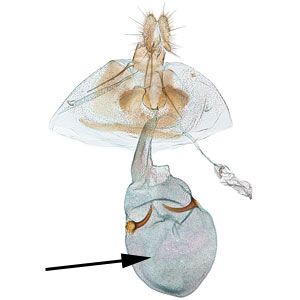 .
.
The following account is summarized from MacKay (1962a).
Mature larva approximately 12-15 mm in length; width of head 1.1-1.3 mm; head brownish yellow, darker pigmentation present laterally; prothoracic shieldprothoracic shield:
a sclerotized plate on the dorsal surface of the prothorax 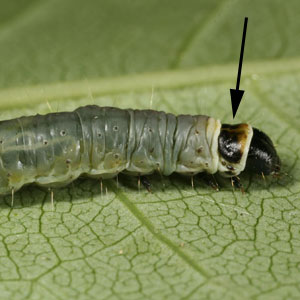 concolorous, including black laterallateral:
concolorous, including black laterallateral:
to the side markings; body yellowish white to cream with small, concolorous pinaculapinacula:
markings; body yellowish white to cream with small, concolorous pinaculapinacula:
flattened sclerotized plates on a caterpillar that bear the setae ; anal shieldanal shield:
; anal shieldanal shield:
a sclerotized plate on the dorsal surface of the last abdominal segment (in larvae) 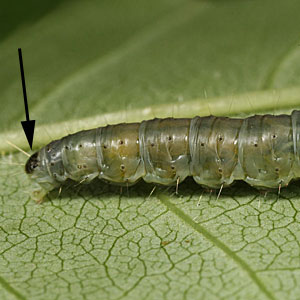 concolorous with body or brown; anal fork present with 5-6 teeth; SV group on A1, 2, 7, 8, 9 numbering 3:3:3:2:2.
concolorous with body or brown; anal fork present with 5-6 teeth; SV group on A1, 2, 7, 8, 9 numbering 3:3:3:2:2.
Detailed figures of larval chaetotaxychaetotaxy:
the arrangement of setae (in reference to Lepidoptera larvae), often depicted on a "setal map"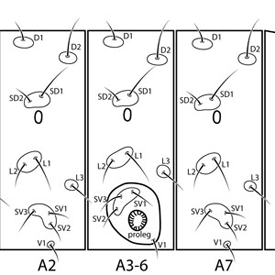 are available in MacKay (1962a).
are available in MacKay (1962a).
Platynota stultana is similar to other Platynota species such as Platynota flavedana and Platynota rostrana. The forewing costal foldforewing costal fold:
a flap or fold at the base of the forewing that contains specialized sex scales is generally smaller in P. stultana than in these other species. A genitalic dissection can be used to confirm identity.
is generally smaller in P. stultana than in these other species. A genitalic dissection can be used to confirm identity.
MacKay (1962a) stated that larvae of Platynota could be separated from similar species of Sparganothis by the small dorsaldorsal:
upper, to the top, on the back  pinacula on A1-8, which are slightly elongate and cream colored in living individuals.
pinacula on A1-8, which are slightly elongate and cream colored in living individuals.
The following account is summarized from AliNiazee & Stafford (1972), Atkins et al. (1957), and Powell & Brown (2012).
Platynota stultana completes 4-6 generations per year. Adults may be present year round over much of its range.
Eggs are laid in masses containing an average of 97 individual eggs per mass. Newly hatched larvae move towards the top of the plant and feed within a bud or between two leaves. Young larvae may also disperse to other hosts by ballooning in the wind on a silk thread. Later instars feed within a shelter constructed of rolled or folded leaves. Larvae complete 5-6 instars in a period of 20-30 days (in greenhouse conditions). Third through fifth instar lavae of the last generation overwinter in webbed nests. Pupation takes place in a rolled leaf.
Larvae of P. stultana are highly polyphagous and have been recorded feeding on plants in more than 20 families. This species can be a serious pest in greenhouses and vineyards and economically important hosts include alfalfa, Citrus sp., corn, cotton, grape, peach, pear, and pepper. As P. stultana expanded its range into northern California it appears to also have greatly expanded its host range onto a wide variety of non-native plants. It is recorded from only a few native plants in California.
| Host plant | Host plant family | Reference(s) | |||||||||
| Amaranthus sp. | Amaranthaceae | Miller & Hodges 1995; Powell 2006Powell 2006: Powell, J. A. 2006. Database of Lepidoptera rearing lots, 1960-2005. University of California Berkeley, CA. |
|||||||||
| Apium graveolens | Apiaceae | MacKay 1962aMacKay 1962a: MacKay, M. R. 1962a. Larvae of the North American Tortricinae (Lepidoptera: Tortricidae). Canadian Entomologist, Supplement 28: 1-182. |
|||||||||
| Conium maculatum | Apiaceae | Powell 2006Powell 2006: Powell, J. A. 2006. Database of Lepidoptera rearing lots, 1960-2005. University of California Berkeley, CA. |
|||||||||
| Ambrosia dumosa | Asteraceae | Goeden & Riker 1976a, b | |||||||||
| Ambrosia psilostachya | Asteraceae | Powell 2006Powell 2006: Powell, J. A. 2006. Database of Lepidoptera rearing lots, 1960-2005. University of California Berkeley, CA. |
|||||||||
| Aster sp. | Asteraceae | Powell 2006Powell 2006: Powell, J. A. 2006. Database of Lepidoptera rearing lots, 1960-2005. University of California Berkeley, CA. |
|||||||||
| Baccharis pilularis | Asteraceae | Keifer 1933Keifer 1933: Keifer, H. H. 1933. California Microlepidoptera. VI. Calif. Dept. Agric. Month. Bull. 22: 351-365.; Meyrick MS 1938Meyrick MS 1938: Meyrick MS 1938. Unpublished manuscript by E. Meyrick at BMNH, data captured by Gaeden Robinson. |
|||||||||
| Bidens laevis | Asteraceae | Powell 2006Powell 2006: Powell, J. A. 2006. Database of Lepidoptera rearing lots, 1960-2005. University of California Berkeley, CA. |
|||||||||
| Conyza bilbaoana | Asteraceae | Powell 2006Powell 2006: Powell, J. A. 2006. Database of Lepidoptera rearing lots, 1960-2005. University of California Berkeley, CA. |
|||||||||
| Grindelia camporum | Asteraceae | Powell 2006Powell 2006: Powell, J. A. 2006. Database of Lepidoptera rearing lots, 1960-2005. University of California Berkeley, CA. |
|||||||||
| Grindelia hirsutula | Asteraceae | Powell 2006Powell 2006: Powell, J. A. 2006. Database of Lepidoptera rearing lots, 1960-2005. University of California Berkeley, CA. |
|||||||||
| Parthenium hysterophorus | Asteraceae | BMNH collectionBMNH collection: BMNH collection. Based on identified reared specimens in the collection of The Natural History Museum, London; identifications by staff of the Lepidoptera Section.; McClay et al. 1995McClay et al. 1995: McClay, A. S., Palmer, W. A., Bennett, F. D., Pullen, K. R. 1995. Phytophagous arthropods associated with Parthenium hysterophorus (Asteraceae) in North America. Annual Review of Entomology. 24: 796-809. |
|||||||||
| Senecio jacobaea | Asteraceae | Frick & Hawkes 1970 | |||||||||
| Solidago californica | Asteraceae | Powell 2006Powell 2006: Powell, J. A. 2006. Database of Lepidoptera rearing lots, 1960-2005. University of California Berkeley, CA. |
|||||||||
| Wyethia angustifolia | Asteraceae | Powell 2006Powell 2006: Powell, J. A. 2006. Database of Lepidoptera rearing lots, 1960-2005. University of California Berkeley, CA. |
|||||||||
| Dianthus caryophyllus | Caryophyllaceae | Miller & Hodges 1995 | |||||||||
| Dianthus sp. | Caryophyllaceae | Bohart 1942Bohart 1942: Bohart, R. M. 1942. Platynota stultana as a pest of field-grown carnations. Journal of Economic Entomology. 35: 399-403. |
|||||||||
| Atriplex calotheca | Chenopodiaceae | Powell 2006Powell 2006: Powell, J. A. 2006. Database of Lepidoptera rearing lots, 1960-2005. University of California Berkeley, CA. |
|||||||||
| Beta vulgaris | Chenopodiaceae | Powell & Brown 2012 | |||||||||
| Beta sp. | Chenopodiaceae | Powell 1983Powell 1983: Powell, J. A. 1983. Expanding geographical and ecological range of Platynota stultana in California (Lepidoptera: Tortricidae). Pan-Pacific Entomologist. 59: 233-239. |
|||||||||
| Chenopodium sp. | Chenopodiaceae | Powell 1983Powell 1983: Powell, J. A. 1983. Expanding geographical and ecological range of Platynota stultana in California (Lepidoptera: Tortricidae). Pan-Pacific Entomologist. 59: 233-239. |
|||||||||
| Salsola kali | Chenopodiaceae | Powell 2006Powell 2006: Powell, J. A. 2006. Database of Lepidoptera rearing lots, 1960-2005. University of California Berkeley, CA. |
|||||||||
| Convolvulus sp. | Host plant table (embedded)
View full screen host table here DistributionPlatynota stultana was described from Mexico and was possibly also native to Arizona. It has subsequently significantly expanded its range to include much of California (Powell 1983a), southern Texas, Florida (where it is now established). It has also been sporadically reported from Virginia, Washington, D.C., North Carolina, Oklahoma, and Colorado. Platynota stultana has been introduced to the Hawaiian Islands (Miller & Hodges 1995) where it has been collected on Oahu, Lanai, Kahoolawe, Maui, and Hawaii (Austin & Rubinoff, 2022). It has recently been reported from Europe (Powell & Brown 2012). Photo CreditsFigs. 6-9: University of California Statewide IPM Program (UC IPM Web Site) LinksAdditional photos and a distribution map of this species in North America are available at Moth Photographers Group. |